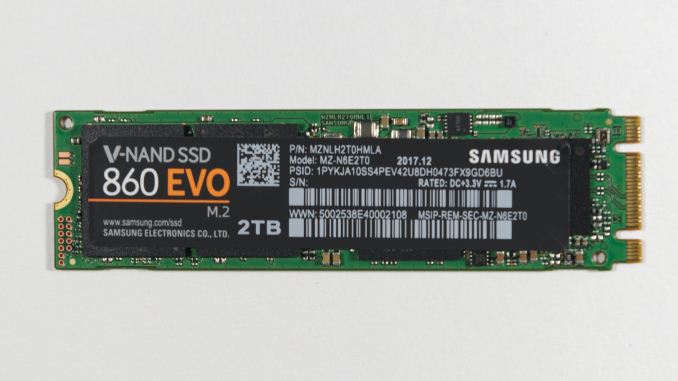The Latest High-Capacity M.2: The Samsung 860 EVO 2TB SSD, Reviewed
by Billy Tallis on February 14, 2018 1:40 PM ESTConclusion
Samsung's update to their TLC SATA SSD is not quite as impressive as the improvements the MLC-based 860 PRO showed, but the Samsung 860 EVO's gains are still enough to put Samsung back on top in that product segment. The competition had caught up to the 850 EVO and surpassed it in several cases in recent months, but Samsung can still deliver a top-notch SSD.
The 860 EVO's performance did not improve in every metric, but on most of them it is slightly faster than the 850 EVO and it is usually as fast as any other TLC SATA SSD. The small handful of regressions should not have much effect on normal use and are not particularly severe even on synthetic benchmarks.
The Samsung 860 EVO's power consumption never goes much above 2W, regardless of the workload. At idle, it uses less power than any other drive in its class. However, total energy usage on our ATSB tests is still trailing behind some of the competitors, so the 860 EVO isn't the unqualified best choice for maximizing battery life.
Overall, the performance and power consumption of the Samsung 860 EVO make it a worthy successor to the 850 EVO. It does not offer any compelling reason for current users of an 850 EVO or similar SSD to upgrade, but the improvements are measurable, if otherwise usually imperceptible. For new systems, the 860 EVO is a reasonable offering for today's market, provided the price is right.
| SATA SSD Price Comparison | |||||
| 240-275GB | 480-525GB | 960-1050GB | 2TB | ||
| Samsung 860 EVO | $94.99 (38¢/GB) |
$169.99 (34¢/GB) |
$299.99 (30¢/GB) |
$649.99 (32¢/GB) |
|
| Crucial MX500 | $79.99 (32¢/GB) |
$134.95 (27¢/GB) |
$259.99 (26¢/GB) |
$499.99 (25¢/GB) |
|
| Crucial MX300 | $89.99 (33¢/GB) |
$147.45 (28¢/GB) |
$269.99 (26¢/GB) |
$528.70 (26¢/GB) |
|
| Samsung 850 EVO | $87.99 (35¢/GB) |
$149.99 (30¢/GB) |
$349.20 (35¢/GB) |
$697.95 (35¢/GB) |
|
| SanDisk Ultra 3D | $79.99 (32¢/GB) |
$129.99 (26¢/GB) |
$270.50 (27¢/GB) |
$499.99 (25¢/GB) |
|
| WD Blue 3D NAND | SATA | $79.99 (32¢/GB) |
$134.99 (27¢/GB) |
$259.99 (26¢/GB) |
$499.99 (25¢/GB) |
| M.2 | $90.41 (36¢/GB) |
$139.99 (28¢/GB) |
$289.99 (29¢/GB) |
$599.99 (30¢/GB) |
|
| Samsung 860 PRO | $139.99 (55¢/GB) |
$249.99 (49¢/GB) |
$479.99 (47¢/GB) |
$949.99 (46¢/GB) |
|
| Intel 545s | $89.99 (35¢/GB) |
$149.99 (29¢/GB) |
|||
| Crucial BX300 | $87.99 (37¢/GB) |
$144.99 (30¢/GB) |
|||
Looking specifically at 2TB M.2 SATA alternatives to the drive in this review, we find the WD Blue 3D NAND is $50 cheaper, and the 860 EVO is definitely not worth $50 more. Broadening the price comparison to include 2.5" models, the competition is much stronger. The 860 EVO is still selling at MSRP, and those prices are not competitive. The 2TB Crucial MX500 for $500 makes a lot more sense than the 2TB 860 EVO for $650.
Across the full range of capacities, Samsung is trying to continue charging a premium that their product no longer justified, because the alternatives are just as good. 30¢/GB should be about the upper limit of pricing on the 860 EVO, instead of being the lower limit.
As 64L 3D TLC finds its way out to other brands and as the other NAND manufacturers start supplying their 512Gb 64L TLC parts in volume, the competition will only increase. Samsung's reputation can guarantee the 860 EVO a lot of sales, but there are better deals out there.












32 Comments
View All Comments
DanNeely - Wednesday, February 14, 2018 - link
Did you do the performance tests via the sata-m2 adapter too? If so will you be re-running them in PCIe mode next?JanW1 - Wednesday, February 14, 2018 - link
This is a M.2 SATA drive, no point in trying to run tests in PCIe mode.Flunk - Thursday, February 15, 2018 - link
I can already tell you the results, they're all 0.Drazick - Wednesday, February 14, 2018 - link
M.2 is perfect for Laptop's.Why don't we see U.2 for Desktop's?
It will mitigate most throttling issues.
Not to say simplify the Mother Boards.
CheapSushi - Thursday, February 15, 2018 - link
There are U.2 for desktops....But U.2 is NVMe/PCIe based. This is SATA/AHCI. You can turn a mini-SAS port and I think U.2 (correct me if wrong) into a quad SATA port with appropriate cable. Nothing wrong with SATA/AHCI for a bulk storage drive. Unless you'e assuming everyone just wants ONE drive for the entire system.BurntMyBacon - Thursday, February 15, 2018 - link
In a system you would want to use the U.2 port in, there is a decent probability that a second drive will be desired if not already present. Like you said, "Nothing wrong with SATA/AHCI for a bulk storage drive". For systems that you can rule out a bulk storage drive, there is a high probability that nVME needs will be served by M.2 rather than U.2.Though some can tell a difference, it is not even certain that most perceive the performance benefit moving from a fast SATA SSD to an nVME SSD for a primary disk due to how current operating systems handle the storage subsystem.
Bulat Ziganshin - Thursday, February 15, 2018 - link
3dnews.ru testing shown that 512 GB model sometimes is slower than 850EVO, due to lower parallelism. It's why Samsung sent you 2TB model for tests insteadyankeeDDL - Thursday, February 15, 2018 - link
Why was the 960 EVO/PRO not included?SpaceRanger - Thursday, February 15, 2018 - link
Because this is a SATA drive, not an NVME drive.Flunk - Thursday, February 15, 2018 - link
As such they utterly destroy this.